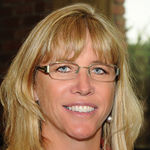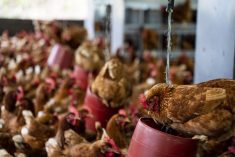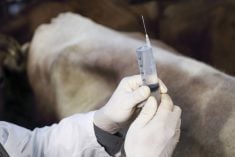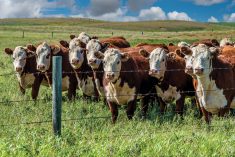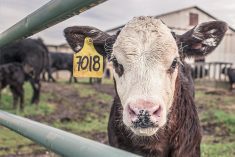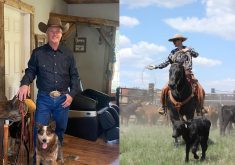Who’s driving this bus?
Amid ‘grocery wars,’ Jamie Oliver, ‘hormone free,’ Walmart, and a storm of related debate, this is the core question many producers and others in animal agriculture have about the new swath of expectations and ‘sustainability’ programs taking hold in the industry and the marketplace.
One person with a unique, up-close perspective on what’s happening at both the ranch and the boardroom level, is Cherie Copithorne-Barnes, a fourth-generation rancher and CEO of CL Ranches, which grazes around 28,000 acres near Jumping Pound, just west of Calgary.
Copithorne-Barnes grapples daily with the practical realities of today’s rising pressures on animal agriculture and has also dealt directly with many of the movers and shakers behind initiatives at Sobeys, A&W, McDonald’s and others.
She also has a front-row seat to developments both nationally and internationally, through her role as chair of the Canadian Roundtable for Sustainable Beef.
Copithorne-Barnes spoke at the 5th Annual UCVM Beef Cattle Conference in Calgary in June and offered a number of insights.
Read Also

Horns aren’t unlocking anytime soon on livestock transport standards
Standards good enough meet the definition of “humane” animal transportation still vary widely between what what industry wants, what animal rights advocates want and, between the two, what federal regulators decide is good enough.
Undercover visit
In July 2013, unbeknownst to her, a marketing representative of celebrity chef Jamie Oliver posed as a member of the Sobeys meat team out for a tour of the ranch, asking questions about animal welfare and videotaping her answers.
“I thought it was a little odd that he was adamant about seeing our feedlots, even though we had emptied them out about the third week of April. He wanted to see the pens. And when we got there one of the questions he asked was, ‘Why would you put all of these calves into these backgrounding pens when you have these big, beautiful open fields?’
“I was beginning to get a bit suspicious of the line of questioning and I said, ‘Think of yourself being here in the middle of January when it’s 40 below, the wind is blowing, and there’s a foot of snow on the ground. Where would you rather be? In these pens with the protection of the fence, clean bedding and adequate food, or out in the open field, facing that wind?’”
A month later she learned the truth about the covert mission — Oliver’s team was evaluating beef suppliers to help Oliver decide if he would participate with Sobeys on what has become the “Sobeys and Jamie Oliver Partnership,” a high-profile marketing initiative built around the “Certified Humane” concept.
She may not agree with all parts of the approach, but Copithorne-Barnes said it’s hard to fault Sobeys from a purely business perspective.
“How do you say this was a wrong move for Sobeys to make? Jamie Oliver has 4.5 million (Twitter) followers. This is a man of incredible influence.”
‘Better Beef’
The next group to visit was A&W, which was considering a “Better Beef” campaign, which promises beef with no added hormones and steroids.
“Before A&W rolled out its marketing plan, its executives actually took the time to come out and visit a number of operations,” she said. “The questions they asked were real, genuine, and they really tried to learn and understand. But we all know the reality of their marketing when they rolled this program out. I am no way endorsing the fact that to call this better beef was responsible. Thankfully, even they eventually started to realize the negative impact this was having at the producer level. That’s why you don’t see the words better beef in the slogan anymore.”
Despite the damage caused, again it’s hard to argue the business rationale, she said.
“A&W decided that the hormone-free concept was something its consumers were asking for. It needed to learn how to supply it and it became the very first national hormone-free burger available to Canadians. Business is business whether we like it or not. It had to follow consumers’ dollars and this is where A&W decided to go.”
‘Verified sustainable’
Arguably the most important retailer initiative is McDonald’s pledge to begin purchasing “verified sustainable” beef in 2016, with Canada selected for the company’s first verified sustainable beef pilot project.
Copithorne-Barnes said the inclusive and collaborative approach McDonald’s has chosen is encouraging and arguably the best among the big retailers.
“It’s really been a driving force in bringing together a multi-collaborative platform in order to ensure that sustainable beef will be defined in a way that everybody can define and accept.”
That multi-stakeholder process stands in contrast to the opportunistic approaches of some companies, she said.
“You look at one of the more extreme examples, such as what Chipotle in the U.S. is doing, where it’s clear it has decided to drive consumers’ thinking for its own gain, whether there’s truth or not to how it is representing things,” she said. “McDonald’s, on the other hand, wants to make sure that everyone involved in this concept has a voice at the table and it gets it right.”
This means working with the Canadian Cattlemen’s Association, the Canadian roundtable, Alberta Beef Producers, and many other industry players. It also includes a strong science basis.
This shows in McDonald’s position on antimicrobial use. Rather than promote antibiotic free, it supports ‘judicious decision-making.’ Bruce Feinberg, McDonald’s global animal health and welfare officer, has simply stated: “McDonald’s believes that animals deserve care and we still support the treatment of sick animals.”
It’s important for producers to have clear, science-based criteria that aren’t unfairly restrictive, said Copithorne-Barnes.
“This is more likely to happen when industry is part of the decision-making team.”
The road ahead
Copithorne-Barnes’ take on Walmart is an interesting one.
The company recently urged its meat and egg supplier to curb antimicrobial use, which garnered massive media coverage.
“The press called this absolutely earth shattering and a game changer, which made me laugh because it was about the last one in the game.”
But she was still relatively happy at where Walmart landed.
“What I was most proud of with Walmart is that for once it was a recommendation. Walmart has a tendency to send out prescriptive edicts. ‘You will or else we won’t.’ This was the first time when it comes to a sustainability factor that Walmart has said we ‘recommend,’ and the reality is I think a lot of that has to do with McDonald’s and others making a lot of headway through the concept of collaboration.”
But there are other issues to deal with.
“For example, I know first hand that antimicrobials are just the first step. We will be facing more questions about Ractopamine and hormones coming up very soon.”
But the recent signs of progress are also encouraging, she said.
“If we can keep what we’re doing open and transparent, at both a national and global level, hopefully these companies such as Walmart, Unilever, Nestlé, that are all walking down this path right now, will pay attention to this and we will have approaches we can live with.”
It’s important for the beef industry to work together, reach out to consumers and retailers, and “continually come up with new and creative ways to influence and deliver our messages.”
Social media will be a key part of that, but old-style communication is, too.
“One of the most productive things I’ve been able to accomplish in the past year and a half is to have people come out to the ranch so I can show them what we’re doing,” she said. “It’s one thing to have a 400-page document explaining what we’re doing. It’s another if you can see it or if I can tell you in my own words.
“We don’t need to get complicated. Just talk about the simple things we do every day and why we do them. That can go a long way.”


